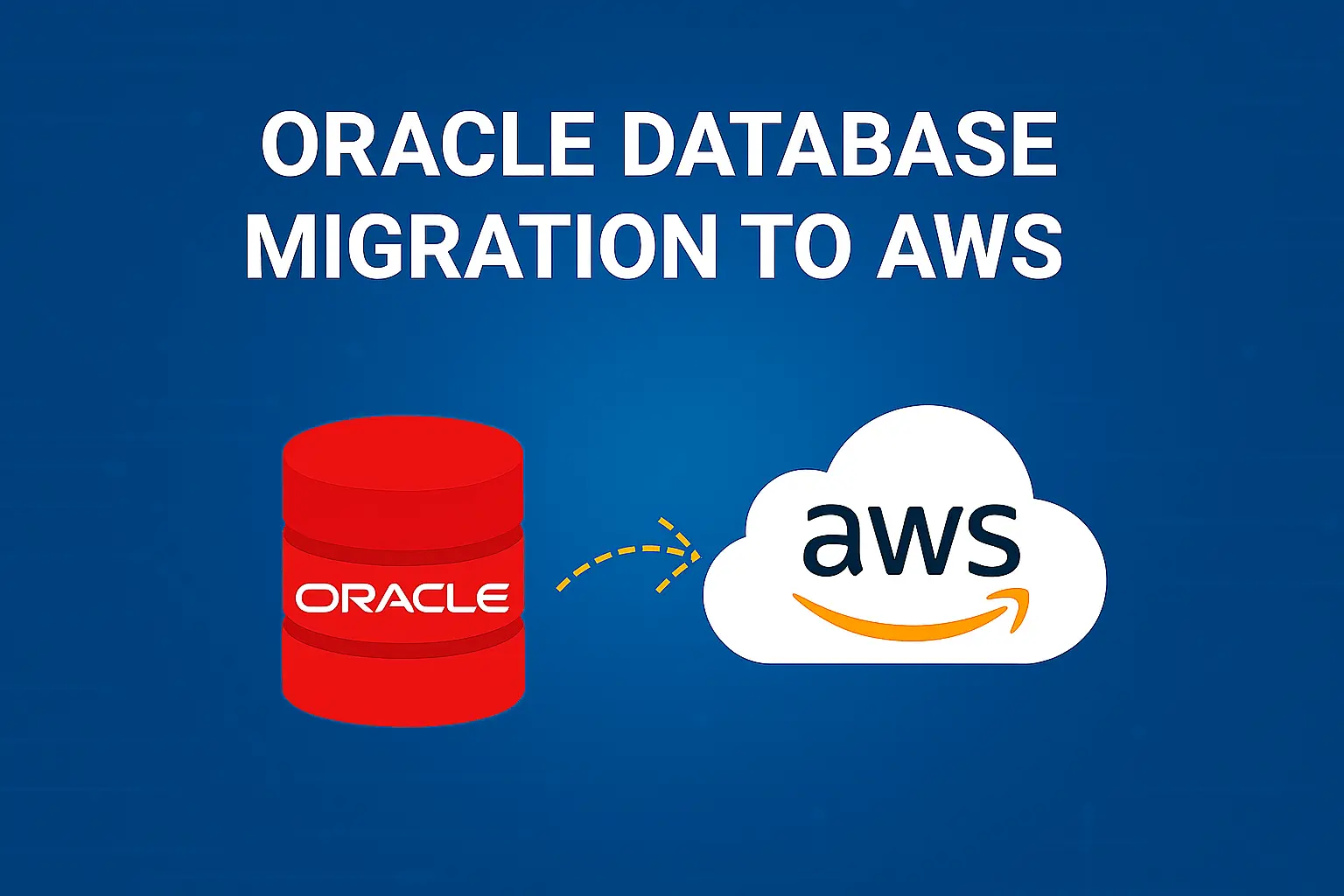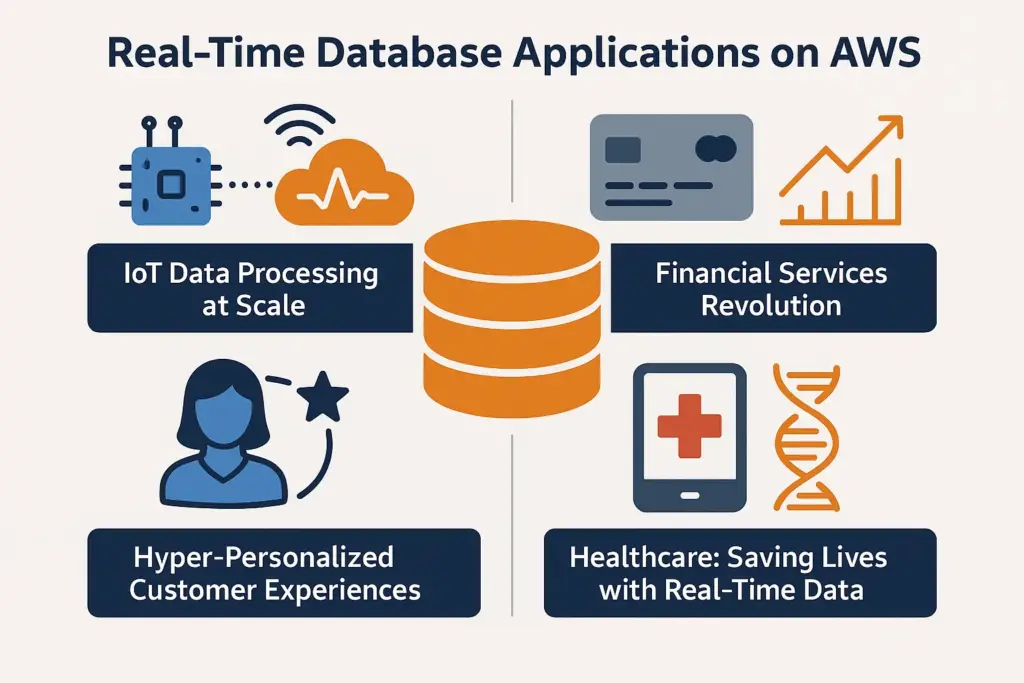The Complete Guide to Oracle Database Migration to AWS
Written by: Wasil Abdal
Aug 4, 2025 - 7 minutes read

Oracle database migration to AWS represents a critical transformation for enterprises seeking enhanced scalability, cost efficiency, and innovation readiness. As Oracle phases out extended support for legacy versions, organisations face mounting pressure to modernise their data infrastructure. The AWS ecosystem offers compelling advantages: 40-60% cost reduction, near-infinite scalability, and enterprise-grade security frameworks that comply with SOC 2, HIPAA, and GDPR standards. Beyond financial benefits, migrating Oracle databases to AWS enables integration with advanced analytics and machine learning services, positioning businesses for data-driven decision-making in real-time environments.
Pre-Migration Assessment: Foundational Steps
Successful migration begins with rigorous assessment. First, evaluate database compatibility: AWS supports Oracle 19c and 21c through Amazon RDS, while older versions (11g, 12c) require upgrades before migration. Next, analyse workload dependencies—legacy applications tied to specific Oracle features may need refactoring. Performance benchmarking is equally critical: capture AWR reports, I/O throughput metrics, and network latency baselines to size AWS resources accurately.
Key considerations include:
Storage Requirements: Amazon RDS supports up to 64 TiB, but larger datasets may need sharding strategies.
Licensing Models: AWS License Mobility allows “Bring Your Own License” (BYOL), while EC2 Dedicated Hosts suit complex compliance needs.
Network Architecture: AWS Direct Connect establishes private fibre links between on-premises data centres and AWS, reducing transfer times by 50% compared to the public internet.
Performance benchmarking prevents post-migration surprises. Capture:
- AWR reports identifying CPU-intensive queries
- I/O throughput metrics to right-size EBS volumes
- Dependency maps for legacy applications tied to Oracle features like Advanced Queuing (AQ)
Pro Tip: Use AWS DMS Fleet Advisor to automate the inventorying of schemas and workload patterns
Migration Strategies: Choosing Your Path
Homogeneous Migration (Oracle-to-Oracle)
This approach minimises re-engineering:
- AWS Schema Conversion Tool (SCT) automates schema transformation, resolving 80% of compatibility issues.
- Oracle Data Pump exports/imports data via Amazon S3 buckets, ideal for databases under 10 TB.
- For near-zero downtime, AWS Database Migration Service (DMS) replicates changes continuously, achieving Recovery Point Objectives (RPO) of <5 minutes.
Heterogeneous Migration (Oracle-to-Aurora/PostgreSQL)
For cost optimisation:
- AWS SCT converts PL/SQL to PostgreSQL-compatible code, though complex stored procedures may require manual refinement.
- Amazon Aurora PostgreSQL offers Oracle compatibility mode, executing Oracle SQL syntax natively while reducing licensing costs by 90%.
Hybrid Approach
Mission-critical systems can leverage Oracle Database@AWS, running Oracle Exadata within AWS data centres. This multicloud model maintains Oracle’s high performance while integrating with AWS analytics services.
Migration Execution: Technical Deep Dive
Data Transfer Optimisation
Transferring large datasets demands precision:
- AWS Snowball Edge physically transports petabyte-scale data, bypassing network constraints.
- Incremental Loading: DMS captures ongoing changes during bulk transfer, synchronising source and target databases before cutover.
- Data Validation: AWS DMS Validator compares checksums to ensure bit-for-bit accuracy pre-switch.
Handling Oracle-Specific Features
- Advanced Queuing (AQ): Replace with Amazon SQS or Kinesis for message brokering.
- Materialised Views: Recreate using Amazon Redshift materialised views for analytics workloads.
- XML DB: Migrate to Amazon DocumentDB or DynamoDB to handle JSON/XML documents.
Minimizing Downtime
- GoldenGate Integration: Achieves sub-second replication latency for financial systems.
- Blue/Green Deployment: Run parallel environments, routing traffic to the new AWS database after validation.
- Rollback Strategy: Maintain synchronised backups until stability is confirmed.
Post-Migration Optimization
Performance Tuning
- Amazon RDS Performance Insights visualises database load, identifying top SQL queries needing optimisation.
- Parameter Group Adjustments: Optimise MEMORY_TARGET and SGA_MAX_SIZE for AWS instance types.
- Index Rebuilding: Use AWS Lambda to automate index maintenance during off-peak hours.
Cost Governance
- Rightsizing: Shift from db.r5.24xlarge to smaller instances post-migration.
- Reserved Instances: Commit to 1-3 year terms for 40% savings.
- Storage Tiering: Move historical data to Amazon S3 Glacier Instant Retrieval.
Security Hardening
- Encryption: Enable AWS KMS for data-at-rest and in-transit encryption.
- Auditing: Use Amazon CloudTrail and RDS Audit Policies for compliance logging.
- VPC Isolation: Deploy databases in private subnets with security group restrictions.
Real-Time Database Applications on AWS

Before exploring specific applications, it’s essential to understand what makes a database system capable of real-time data processing on AWS. Real-time databases powering modern real-time data processing solutions differ from traditional systems in several fundamental ways:
Core Characteristics of Real-Time Databases:
- Sub-second response times for both reads and writes
- Continuous data ingestion from multiple concurrent sources
- Predictable performance under variable workloads
- Horizontal scalability to handle exponential data growth
- Built-in stream processing capabilities
IoT Data Processing at Scale
AWS’s real-time database capabilities transform IoT ecosystems through Amazon Timestream, a purpose-built time-series database that processes millions of sensor events per second with sub-millisecond latency. Key implementations include:
Predictive Maintenance:
Industrial equipment sensors stream vibration/temperature data to Timestream, where ML models detect anomalies 5–10x faster than batch systems.
For example, automotive manufacturers use this to predict bearing failures 72 hours in advance, reducing unplanned downtime by 30%.
- Technical Advantage: Timestream’s adaptive query engine skips irrelevant data scans, cutting query costs by 90% vs. relational databases.
Smart City Infrastructure:
Traffic cameras and air quality sensors feed data into Kinesis Data Streams, triggering Lambda functions to:
- Dynamically adjust traffic light timings during congestion (reducing commute times by 22%)
- Alert municipal teams about pollution spikes within 15 seconds of detection.
Edge-to-Cloud Synergy:
AWS IoT Greengrass pre-processes data at the edge (e.g., filtering out normal sensor readings), reducing cloud ingestion costs by 60% while maintaining real-time alerting for critical events.
Financial Services Revolution
Combining Amazon Aurora with streaming services enables:
Fraud Detection:
- Kinesis analyses credit card transactions in <50ms, flagging suspicious patterns (e.g., geographic impossibilities) before authorisation completes.
- Aurora ML integrations cross-reference transactions with historical behaviour, reducing false positives by 35%.
Algorithmic Trading:
- Market data feeds (e.g., NASDAQ TotalView) stream into Amazon MemoryDB for Redis, enabling:
- Microsecond-latency arbitrage calculations
- Real-time portfolio rebalancing based on live volatility indices.
Risk Management:
- Amazon Neptune graphs correlate transactions across entities, uncovering hidden fraud rings 80% faster than SQL joins.
Hyper-Personalised Customer Experiences
E-Commerce & Retail
DynamoDB Accelerator (DAX): Delivers microsecond response times for:
- Personalised product recommendations (boosting conversions by 22%)
- Real-time inventory checks across 10,000+ SKUs.
Real-Time Analytics Pipelines:
Clickstream data flows through Kinesis → Lambda → Redshift, updating recommendation models every 30 seconds based on:
- Live browsing behaviour
- Concurrent purchase trends (e.g., “customers who bought X also bought Y right now“).
Media & Entertainment
Amazon ElastiCache powers:
- Sub-100-ms content recommendations for 50M+ Netflix users
- Live sentiment analysis of social media feeds during broadcasts.
Healthcare: Saving Lives with Real-Time Data
Patient Monitoring:
ICU devices stream vitals to AWS IoT Core, triggering Lambda-powered alerts for:
- Sepsis risk (18% reduction in mortality rates)
- Medication adherence (40% faster nurse responses).
Genomic Analysis:
Amazon Aurora PostgreSQL with pgvector processes DNA sequencing data in real time, accelerating personalised treatment plans by 5x.
Emerging Innovations
- Serverless Real-Time Analytics:
Kinesis Data Firehose + Lambda + Redshift Serverless creates cost-effective pipelines for:- Instant SaaS product analytics (e.g., feature adoption heatmaps)
- Fraud detection without managing infrastructure.
- AI-Enhanced Streams:
Amazon Bedrock integrates with Aurora to:- Generate real-time product descriptions from live inventory data
- Power conversational fraud investigation bots.
- Multi-Model Databases:
Amazon DocumentDB handles JSON streams from mobile apps, enabling:- Real-time profile updates (e.g., loyalty point accrual)
- Instant A/B test result visualisation.
“Real-time databases aren’t just faster—they redefine what’s possible. From preventing heart attacks to predicting market crashes, AWS turns data velocity into business value.”
TeraDB Cloud: Accelerating AWS Migrations
TeraDB Cloud revolutionises Oracle-to-AWS migration by delivering fully managed infrastructure on the AWS backbone. Key advantages include:
Zero-Configuration Deployment:
Prebuilt AWS templates deploy optimised Oracle-compatible environments in <2 hours, eliminating manual VPC/EC2 tuning.
Automated Schema Conversion:
Patented tools convert PL/SQL to AWS-native code with 95% accuracy, handling partitions, indexes, and triggers.
Cost-Efficiency:
Dynamic resource pooling cuts TCO by 40% versus self-managed RDS through spot instance orchestration.
Table: Migration Path Comparison
| Metric | Manual AWS Migration | TeraDB Cloud |
| Deployment Time | 6–12 weeks | <2 Days |
| Downtime Window | 4–8 hours | <15 minutes |
| Ongoing Management | DevOps team required | Fully managed 24/7 |
| Compliance | Manual configuration | Prebuilt GDPR/HIPAA/FIPS 1402 templates |
Conclusion: Future-Proofing Data Architecture
Migrating Oracle databases to AWS transcends infrastructure modernisation—it’s a strategic pivot toward scalability, innovation, and cost efficiency. By following phased assessment, execution, and optimisation protocols, organisations mitigate risks while unlocking advanced capabilities like real-time database processing. As data volumes grow exponentially, AWS-native architectures position enterprises to harness AI, serverless computing, and edge analytics.
Related Posts

Cloud Migration as a Service: The Next Evolution in Enterprise IT
What is Cloud Migration as a Service? Cloud Migration as a Service (CMaaS) is an end-to-end managed solution where specialised providers handle the entire lifecycle of transferring workloads, data, and applications to cloud environments—from assessment to execution and optimisation. Unlike traditional DIY approaches, CMaaS bundles expertise, tools, and automation into a unified offering, reducing migration […]
Wasil Abdal 08/05/2025